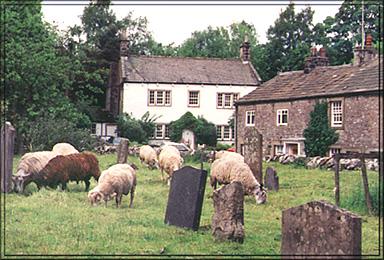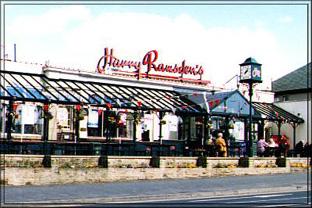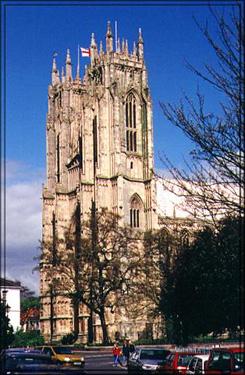APRIL 2001
It is reported that Hull University, at its Scarborough campus, has introduced Yorkshire Studies as part of its humanities degree course. Really. No doubt the course will begin with a warning from the Health and Safety Officer of the dangers of walking on the moors above Ilkley without suitable headgear. There will then be modules (always modules nowadays) on the correct consistency of parkin, the socio-economic origins of chipped potatoes and fish products and the rise and fall of Yorkshire puddings. Now call me a cynic (youíre a cynic) but if the students really want to learn about Yorkshire and all things Yorkshire they should join us at the Princess. Seminars are held every evening and are generally well attended. There are people there who had the equivalent of degrees in Yorkshire culture before they were even thought of in the rarified academic atmosphere of the dreaming spires of Scarborough.
| The
press tells us that Bill Bryson is returning to live in England. This is great
news. When he last was here he lived in Malhamdale and I have many times
enjoyed his observations on life in the Limestone Dales. But he is quoted as
saying that he plans to reside in London or Dorset or such place. Oh dear,
Bill; you wonít enjoy it half so much. He says in his entertaining Notes
from a Small Island: ĎI suppose everybody has a piece of landscape somewhere
that he finds captivating beyond words and mine is the Yorkshire Dales. I
canít account for itÖAll I can say is that the Dales seized me like a
helpless infatuation when I first saw them and will not let me goí. Amen. |
Kirkby Malham, once the home of Bill Bryson |
|
Brimham Rocks |
We
canít go to Brimham Rocks or Fountains Abbey at present because of the foot
and mouth disease outbreak, so last weekend we went to Nostell Priory, a
National Trust property between Ackworth and Wakefield. It has recently
re-opened after extensive redecoration and conservation work. The house gets
its name from the priory which was founded here in the twelfth century and
existed until the Dissolution of the Monasteries. The present house was built
in the eighteenth century to designs by James Paine and Robert Adam. The
interior is packed with the furniture of Thomas Chippendale together with all
sorts of other treasures. Nostell Priory has survived fire and mining
subsidence and now, thanks to the National Trust, is probably in better shape
than it has been for a long time. |
| Another
historical Yorkshire landmark has re-opened. Having been closed for
refurbishment, Harry Ramsdenís, the well-known fish and chip emporium at
Guiseley is frying again. Traditionalists may be a little alarmed to learn
that as well as haddock and chips one can now order chargrilled swordfish or
moules mariniere. Personally I think that if you want chargrilled swordfish,
or any other type of swordfish come to that, you go to Arts Cafť in Call Lane
or some other good bistro but then I still buy my electricity from Yorkshire
Electricity. Anyway those same traditionalists will be reassured to know that
the chandeliers have survived and the original hut in which Harry started his
business in 1928 is still there as a tourist attraction. |
|
A
pen and ink drawing by Michelangelo was discovered last year in the library at
Castle Howard. It is to be sold for £7.5 million. Itís amazing what you
find when you clean out your drawers, isnít it?
| Several
times recently I have travelled back from Hull using the ordinary roads rather
than the motorways. First one sees Beverley Minster presiding over the souls
of this part of the East Riding, the first area of Yorkshire to be colonised
by the Angles after the Romans left. Bishop Burton looks delightful, its
attractive houses built around the green and the village pond. There are great
views across Yorkshire from the hills above Market Weighton and then one goes
on a Roman road via Pocklington to York. Next Tadcaster, once a Roman town,
now dominated by the John Smithís brewery. After Boston Spa and Wetherby one
drives along Harewood Avenue, straight as an arrow on the ridge above the
Wharfe, until one reaches the entrance to Harewood House. This was built in
1759 from the huge profits of West Indian sugar plantations, its gardens laid
out by Capability Brown. One skirts the Harewood estate to Pool, now being
developed and in serious danger of going the same way as Burley in Wharfedale
which would be barely recognisable to someone visiting it today for the first
time for twenty years. One climbs Pool Bank from the top of which on a clear
day you can see all the way to Emley Moor to the south and Queensbury and the
windmills at Ogden above Halifax to the west. Itís about sixty-five miles
from Hull to Rawdon and one reflects on the variety of this county of ours.
The red roofs of East Yorkshire, the blackened stone roofs of the West Riding.
The Vale of York, the Pennine hills. The parish churches in the old villages,
the Nonconformist chapels in the towns. And the history all around us Ė
Roman Britain, the old kingdom of Elmet, village life, the isolated farms, the
Industrial Revolution, modern uniformity. |
Beverley Minster |
|
|
Itís the end of an era at the Princess. The landlord, who has run the pub as a family business for ten years, is selling the lease because the rent has been hiked. The Establishment at the east end of the bar is most concerned. Will the beer be kept as well? Will the home cooked food be as good? You have to understand what an institution the Princess is. Monday is quiz night; question the quizmasterís judgement and Anne Robinson is a pussycat in comparison. Tuesday is the folk music, er, folk and Wednesday was the share club until the dot.com collapse left us looking silly. Football teams meet here, charities are promoted, there are carols on Christmas Day and a TV when England plays. There is good conversation, gossip and a wealth of humour. These are worrying times. |





